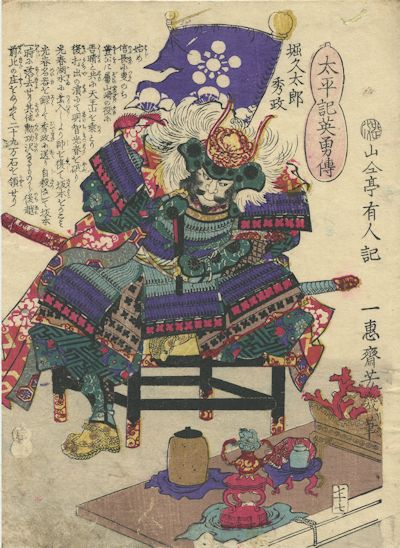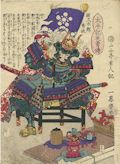| Title: |
Hori Kyutaro Hidemasa, a samurai in full armour (Heroes from the chronicles of the Taiheiki) |
| Artist: |
Yoshiiku, Utagawa 'Ochiai Yoshiiku' (Japan, 1833- 1904) |
| Date: |
1867 |
| Medium: |
Original Japanese Woodcut |
| Publisher: |
Hirookaya Kosuke (Hirokaya Kosuke) |
| Signed: |
Chokaro Yoshiiku ga |
| Series: |
Taiheiki eiyuden (Heroes from the chronicles of the Taiheiki eiyuden) |
| Note: |
Utagawa Yoshiiku (Ochiai Yoshiiku): A fine 19th century Japanese artist of the Utagawa school, Yoshiiku is also known as 'Utagawa Yoshiiku', 'Ochiai Yoshiiku', 'Ikkeisai Yoshiiku', and 'Chokaro'. Many of Japan's greatest
woodcut artists of the latter half of the nineteenth century studied in the workshop of the master artist and designer, Kuniyoshi (1798-1861). The most notable were Yoshitoshi, Yoshiiku, Yoshitora, Yoshikazu and Yoshifuji. The 'Yoshi' prefix, in fact, was somewhat like a title which indicated that these artists belonged to Kuniyoshi's famous school. By the mid 1870's Yoshitoshi had risen to be the most famous artist of his era. Yet, for the decade following the death of Kuniyoshi (in 1861), the heir apparent to carry on his masterful warrior and actor woodcuts was Utagawa Yoshiiku. |
| |
More than any of Kuniyoshi's pupils, Utagawa Yoshiiku continued the striking design elements of his master. These included powerful portrayals of motion and gesture combined with brilliant colour modulations. Yoshiiku's affinity to his master during this decade is reinforced by the fact that he was commissioned to create the important memorial woodcut portrait of Kuniyoshi shortly after his death. |
| |
The Taiheiki eiyuden (Heroes from the chronicles of the Taiheiki eiyuden) was published in 1867 by Hirookaya Kosuke (Hirokaya Kosuke). The completed set consisted of one hundred chuban sized woodcuts, each depicting a famous warrior. The Chronicles of the Taiheiki was a fourteenth century epic covering one of the most troubled and violent epochs of Japanese history. In 1850 Kuniyoshi had designed his own set of woodcuts on this subject entitled, Heroes of the Taiheiki. The designs for this 1867 set were equally divided between Utagawa Yoshiiku (1833-1904) and Ichieisai Yoshitsuya (1822-1867). As both were major students of Kuniyoshi, these woodcuts bear some stylistic similarities to the earlier set. |
| |
Under Kuniyoshi and his pupils, the Warrior print reached its summit during the 1850's and 1860's. In part, impetus for these works of art came from the political and social events of the times. Japan witnessed a series of minor civil wars which led finally to the defeat of the Shogun and the restoration of the monarchy (1868). As well unease over the arrival of Western powers was felt throughout the land. The portrayal of the warrior hero thus assumed great prominence in Japanese woodcut art. |
| |
Hori Hidemasa, also known as Hori Kyutaro Hidemasa was a Japanese samurai warrior, retainer of Oda Nobunaga who was a powerful daimyo of Japan, head of the Oda clan (descendants of the Taira clan), and one of the most formidable warlords of the Sengoku period (a period of social upheaval, disputes, and military conflict in Japanese history marked by many as the 'Age of Civil War'). It has been noted that on of Oda Nobunaga's major goals was national unification as Japan was then ruled by hundreds of autonomous domains (hereditary land holdings), that were under the control of daimyo (powerful feudal lords who ruled Japan). After the death of Lord Oda Nobunaga, Hori Hidemasa served as retainer to the daimyo, Toyotomi Hideyoshi, a famous samurai warrior, and one of Oda Nobunaga's most distinguished generals who later became a dominant ruler during the Sengoku period. Soon after, Hori Hidemasa became one of general Toyotomi Hideyoshi's greatest generals. General Hori Hidemasa participated in many campaigns and, was awarded, Obama castle in Wakasa, Sakamoto castle and various other fiefs for his heroic prowess. Here, Utagawa Yoshiiku depicts General Hori Kyutaro Hidemasa in full samurai armour seated in front of a prayer table. The torn flag behind Hori Hidemasa in this Yoshiiku woodcut depicts the Maeda clan crest (kamon). Lord Maeda Toshiie (1554-1627), of Kaga (now Ishikawa prefecture), was one of the leading generals under Oda Nobunaga and son of Toshimasa. The Maeda clan ruled the Kaga Domain from Kanazawa. The Oda clan crest (mon), known as the (Oda moukkou) was distinctive for its five petals around the edge, and is believed to represent the flowering Japanese quince. The Hori clan crest (mon or kamon), is a stylized Ume (Japanese apricot blossom) in circle. And lastly, the Toyotomi clan crest depicts the paulownia seal which is still used today to represent the government of Japan. Note: During this period, it was not unusual, as it was often recognized as a class distinction, for family members to depicted the clan kamon or variations of it on their garments, household items, armours, and weapons. |
| |
An original woodcut by Utagawa Yoshiiku, Hori Kyutaro Hidemasa, a samurai in full armour hails from the 1867 series: Taiheiki eiyuden (Heroes from the chronicles of the Taiheiki). It is characteristic of the great warrior woodcuts of the 1860's. As the Meiji period (1868-1912) began, the art of the Japanese woodcut fell under the influence of Western trends. Thus this woodcut, with its wonderful form and movement, is indicative of the last great work of the famous classic art of Kuniyoshi, his school and the art of Utagawa Yoshiiku (Ochiai Yoshiiku). |
| Size: |
9 7/8 X 7 (Sizes in inches are approximate,
height preceding width of plate-mark or image.) |
| |
Matted with 100% Archival Materials |
| Buy Now |
Price: $395.00 US |
| Condition: |
Printed on mid nineteenth century Japanese mulberry (rice) paper and with full margins as published by Hirookaya Kosuke (Hirokaya Kosuke) in 1867 for the Taiheiki eiyuden (Heroes from the chronicles of the Taiheiki eiyuden). Signed "Chokaro Yoshiiku ga" in the block. Containing slight scuffing in the margins, else a richly printed impression and in excellent condition throughout. Hori Hidemasa a samurai in full armour from the series Taiheiki eiyuden Heroes from the chronicles of the Taiheiki represents a superb example of the 19th century art of the warrior woodcut and the art of Utagawa Yoshiiku. |
| Important Information: |
The artist biographies, research and or information pertaining to all the original works of art posted on our pages has been written and designed by Greg & Connie Peters exclusively for our site, (www.artoftheprint.com). Please visit us regularly to view the latest artworks offered for sale. We will soon be posting an update of our most recent research and include the biographical and historical information pertaining to our next collection of original works of art created by artists throughout the centuries. We hope you found the information you were looking for and that it has been beneficial.
Our Gallery, (Art of the Print / www.artoftheprint.com) guarantees the authenticity of every work of art we sell 100%. Full documentation and certification is provided. We offer a wide selection of international fine art dating from the early Renaissance to the contemporary art period. |




![]()
![]() or
phone Greg & Connie (905) 957-6666
or
phone Greg & Connie (905) 957-6666